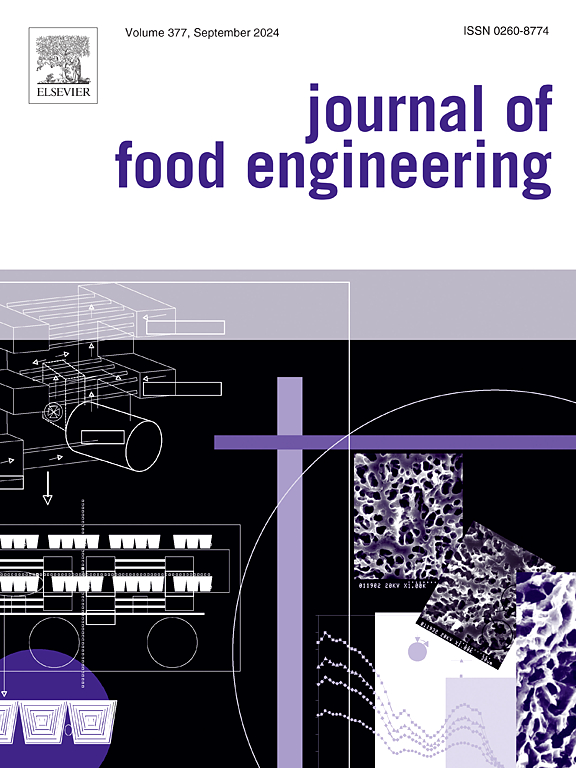Effect of particle size distribution on mass transfer during solid-fluid extraction and its application to coffee brewing
IF 5.3
2区 农林科学
Q1 ENGINEERING, CHEMICAL
引用次数: 0
Abstract
Solid-fluid extraction (SFE) is one of the most important unit operations in the food and chemical engineering fields. This operation is very often modeled by assuming particles of single particle size (SPS); however, experimental evidence indicates that particle size distribution (PSD) affects mass transfer rate and therefore the extract characteristics at a given time. This study introduces a model based on global mass transfer coefficients to describe the SFE considering the PSD. The model was written in terms of dimensionless variables, arranged in a state-space representation for its analytical solution, and further used to investigate the effect of different PSDs on SFE, including normal, uniform, left and right skewed, and bimodal distributions, each one having different characteristics such as their median, fraction of particles above the mean, standard deviation, among others. Besides, the model was applied to estimate the diffusivity () of total soluble solids during coffee brewing of fine and coarse grinds in a packed bed system using data from literature. Results indicated that, depending on the PSD properties and solids-to-fluid volume ratio (between 0.01 and 1), the use of a SPS underestimated up to 16.5, 30.3, and 48.3% the required time to achieve high extraction yields (EY) of 90, 95, and 99%, respectively, but this trend reversed for low EYs, where time was overestimated in up to 47.5 and 34.2% for EYs of 25 and 50%, respectively. The use of a SPS produced significant underestimation of (about 30%) during the mass transfer analysis of coffee brewing (), where it was evaluated as 1.3 × 10−10 m2/s when considering the PSD. The proposed model is a valuable tool to improve the understanding of the ongoing mass transfer mechanisms during SFE as well as to increase the knowledge about the processing of products depending on the PSD such as coffee brews.
粒度分布对固液萃取过程中传质的影响及其在咖啡酿造中的应用
固液萃取(SFE)是食品和化工领域中最重要的单元操作之一。这个操作通常是通过假设单个粒径的粒子(SPS)来模拟的;然而,实验证据表明,粒径分布(PSD)影响传质速率,从而影响给定时间的萃取物特性。本文引入了一个基于全局传质系数的模型来描述考虑PSD的SFE。该模型以无量纲变量的形式编写,以状态空间表示其解析解,并进一步用于研究不同psd对SFE的影响,包括正态分布、均匀分布、左右偏态分布和双峰分布,每种分布都有不同的特征,如中位数、高于平均值的颗粒比例、标准差等。此外,利用文献数据,将该模型应用于填充床系统中咖啡细粉和粗粉冲泡过程中总可溶性固形物的扩散率(DP)的估算。结果表明,根据PSD性质和固液体积比(0.01 ~ 1)的不同,SPS分别低估了达到90%、95%和99%的高萃取率所需时间的16.5%、30.3%和48.3%,但对于低萃取率,这一趋势相反,当萃取率为25%和50%时,时间分别被高估了47.5%和34.2%。在咖啡冲泡的传质分析中,SPS的使用显著低估了DP(约30%)(p<0.05),在考虑PSD时,它被评估为1.3 × 10−10 m2/s。所提出的模型是一个有价值的工具,可以提高对SFE过程中正在进行的传质机制的理解,并增加对依赖于PSD的产品(如咖啡冲泡)加工的知识。
本文章由计算机程序翻译,如有差异,请以英文原文为准。
求助全文
约1分钟内获得全文
求助全文
来源期刊

Journal of Food Engineering
工程技术-工程:化工
CiteScore
11.80
自引率
5.50%
发文量
275
审稿时长
24 days
期刊介绍:
The journal publishes original research and review papers on any subject at the interface between food and engineering, particularly those of relevance to industry, including:
Engineering properties of foods, food physics and physical chemistry; processing, measurement, control, packaging, storage and distribution; engineering aspects of the design and production of novel foods and of food service and catering; design and operation of food processes, plant and equipment; economics of food engineering, including the economics of alternative processes.
Accounts of food engineering achievements are of particular value.
 求助内容:
求助内容: 应助结果提醒方式:
应助结果提醒方式:


